The Cevennes by Train with the Cévenol |
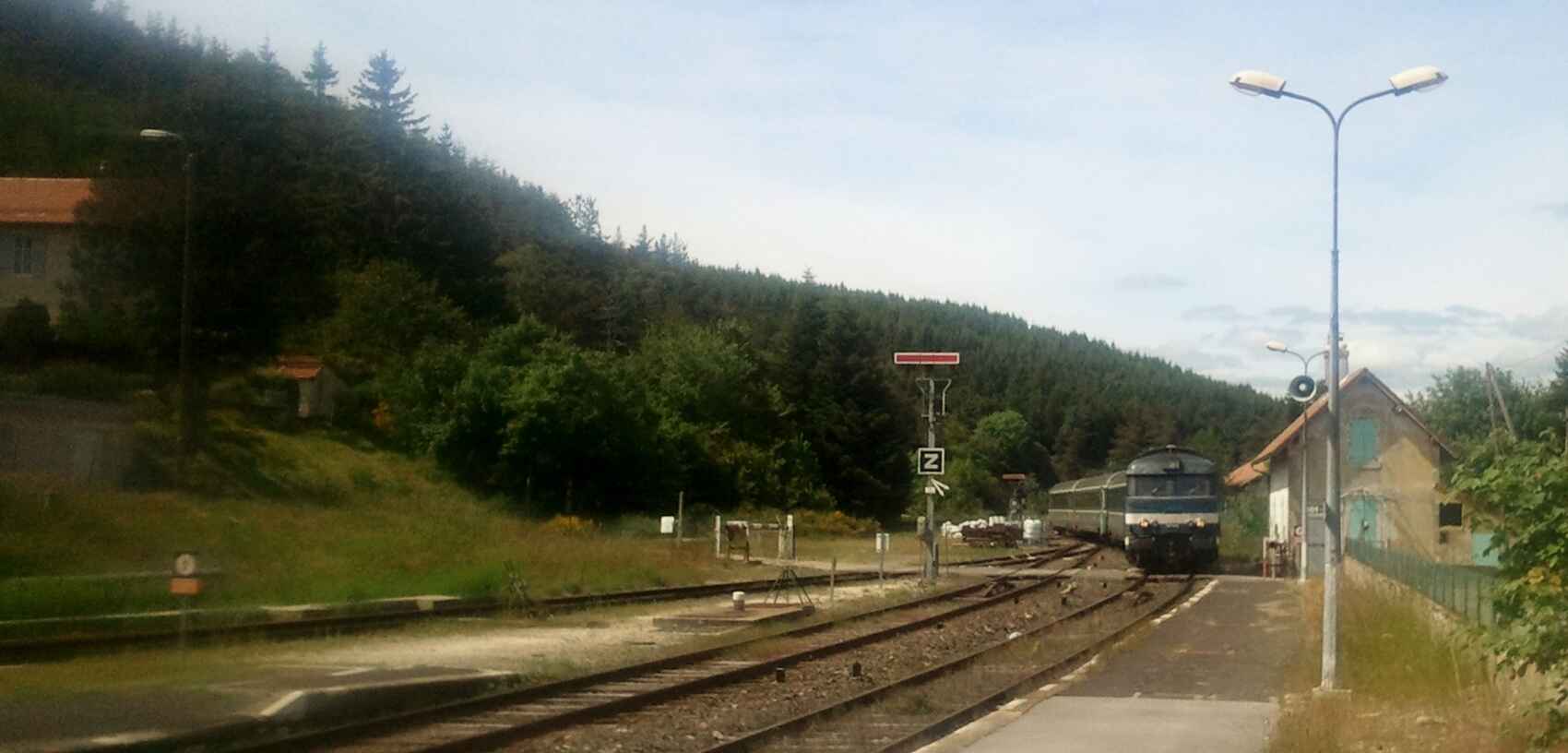
 One does not drive; one admires the scenery. And there’s time to walk. How can one take a morning stroll, change climate, discover new paths, and return home in the evening without having taken the slightest risk on an increasingly deadly road? With a railway line featuring exceptional tourist attractions, operating every day, in the Cévennes region.
One does not drive; one admires the scenery. And there’s time to walk. How can one take a morning stroll, change climate, discover new paths, and return home in the evening without having taken the slightest risk on an increasingly deadly road? With a railway line featuring exceptional tourist attractions, operating every day, in the Cévennes region.
Unfortunately for it, the Nîmes-Clermont-Ferrand line hardly benefits from the promotional leniency of the SNCF as the TGV does. Yet it allows residents of Nîmes and Montpellier, lovers of peaceful hiking, to make round trips in one day to magnificent outings up to 1500 meters in altitude. There are choices for departure (Montpellier): 6:57 AM (except Sundays) or 7:35 AM (every day, with a change in Nîmes). There are choices of destination: among others, Génolhac, nestled on the slopes of Lozère, even higher Villefort with its magnificent water basin surrounded by the steep slopes of the Gorges du Chassezac. And, at the peak, La Bastide-Puylaurent (La Bastide St-Laurent-les-Bains), at an altitude of 1024 meters, just a stone's throw from the triple watershed of the Loire, Rhône, and Garonne, represented by the Allier, Chassezac, and Lot rivers, which spring from the neighboring high plateaus.
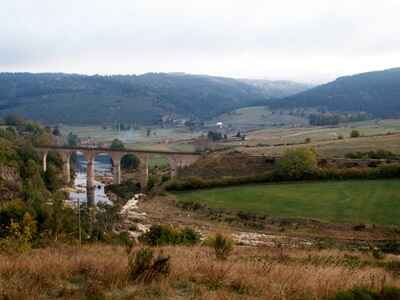 Departing at 7:35 AM, one arrives in these highlands, evoking Slovakia as much as the Massif Central, at 10:15 AM. A little over two and a half hours by train to breathe in one of the most beautiful landscapes in the region. And these two and a half hours are not spent driving behind a heavy truck. With one’s nose pressed against the window of the railcar, one discovers with every turn of the wheel the subtleties of the southern vegetation, then the mountainous. Nîmes garrigues, then the pine groves of the Gardon valley to the north of Alès, chestnut trees from Grand-Combe to Villefort via Chamborigaud and Génolhac, high-altitude genista beyond, with small woods of black pines whose trunks are twisted by the rigors of winter and strong winds.
Departing at 7:35 AM, one arrives in these highlands, evoking Slovakia as much as the Massif Central, at 10:15 AM. A little over two and a half hours by train to breathe in one of the most beautiful landscapes in the region. And these two and a half hours are not spent driving behind a heavy truck. With one’s nose pressed against the window of the railcar, one discovers with every turn of the wheel the subtleties of the southern vegetation, then the mountainous. Nîmes garrigues, then the pine groves of the Gardon valley to the north of Alès, chestnut trees from Grand-Combe to Villefort via Chamborigaud and Génolhac, high-altitude genista beyond, with small woods of black pines whose trunks are twisted by the rigors of winter and strong winds.
From the limestone world of the Gardon valley, we pass to the schist of the slopes of Mt Lozère to reach the granites of Prévenchères, near La Garde-Guérin, a land of standing stones and ancient paths, with the GR®700 Régordane Way linking Saint-Gilles to Puy-en-Velay, the Auvergne of the Black Virgins, which the PLM engineers, one hundred and fifty years ago, decided to faithfully follow. The train, climbing steep gradients of up to 80 per thousand, carves its way through one of the most complex and difficult landscapes there is.
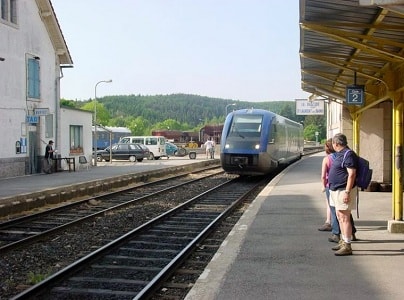 To reach its summit line, just before La Bastide Puylaurent, it snakes along the Gardon before beginning, from Sainte-Cécile d'Andorge, formerly a connecting station with the narrow-gauge train to Florac, a true horse ride: gaining altitude by following a path perpendicular to those of the valleys descending from Mount Lozère. An impressive succession of tunnels and viaducts presents itself to the traveler. With two highlights: the curved viaduct of Chamborigaud, offering a guaranteed spectacle on one of the most beautiful corners of the Cévennes, and the Albespeyre tunnel, higher, so long and steep that it had to be ventilated in the heroic days of steam.
To reach its summit line, just before La Bastide Puylaurent, it snakes along the Gardon before beginning, from Sainte-Cécile d'Andorge, formerly a connecting station with the narrow-gauge train to Florac, a true horse ride: gaining altitude by following a path perpendicular to those of the valleys descending from Mount Lozère. An impressive succession of tunnels and viaducts presents itself to the traveler. With two highlights: the curved viaduct of Chamborigaud, offering a guaranteed spectacle on one of the most beautiful corners of the Cévennes, and the Albespeyre tunnel, higher, so long and steep that it had to be ventilated in the heroic days of steam.
But the journey is not the only pleasant surprise of this expedition. If one goes as far as La Bastide Puylaurent, several great hikes open up to travelers. For the slower ones, the Notre-Dame-des-Neiges trap, the last steps of Charles de Foucauld in France before the desert. A good hour through woods and fields.
For the more courageous, the sources of the Allier, three hours of walking with two routes, one of which partly follows the GR®70 Chemin Stevenson, through beech groves, fir forests, by a fording or in large high-altitude pastures. One can also go discover standing stones, thermal station of St-Laurent-les-Bains, or the beginning of the splendid Allier valley, up to Luc.
In La Bastide-Puylaurent, there are several hotels as well as the guesthouse L'Etoile run by a colorful Belgian, offering lodging, open from June to September, and also all the possible hiking routes in this magnificent region.
The construction of the SNCF line for the train Le Cévenol
The central section from Brioude to Alès in the Gard, Occitanie region, capital of the Cévennes
After a public utility inquiry, the decree of April 9, 1862 pronounces the corresponding declaration and makes the concession definitive. The P.L.M. does not have too many illusions about the local traffic of the new section and is well aware of the technical difficulties of the construction work. But the new section will provide the short tariff distance for transporting the wines of Languedoc to Paris, a distance that the P.L.M. on one hand, and the P.O. aided by the Midi on the other, will dispute with new lines and connections for nearly 50 years. From 1863/1864, the works are awarded between Brioude and Langeac and between La Levade and Le Luech.
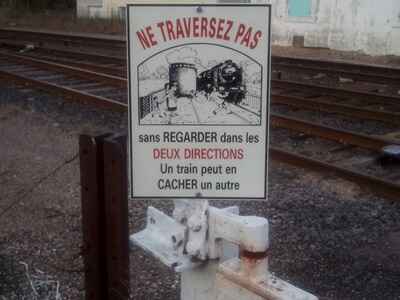 From year to year, the status of the works is established as follows:
From year to year, the status of the works is established as follows:
In 1864:
In 1865:
In 1866:
In 1867:
In 1868:
In 1870:
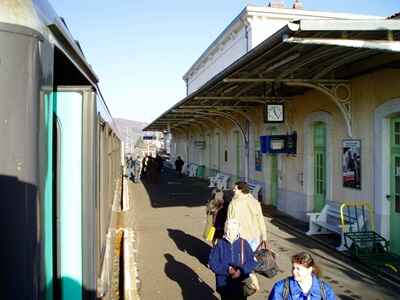 Simultaneously, the P.L.M. Company adapted the installations of the southern section, between La Levade and Alès, which had been a dead end, to take into account transit traffic; this mainly involves track repairs, route rectifications and station enlargements.
Simultaneously, the P.L.M. Company adapted the installations of the southern section, between La Levade and Alès, which had been a dead end, to take into account transit traffic; this mainly involves track repairs, route rectifications and station enlargements.
As of December 31, 1870, the expenses for the section from Saint-Germain-des-Fossés to Alès amounted to nearly 208,000,000 F, which, after deducting the Louis d'or at 500 F, equals 5.2 billion of our francs! In March 1877, the journey from Clermont-Ferrand to Nîmes took 10 hours and 13 minutes in express for all classes with admission conditions and 12 hours in omnibus. In 1898, two trains in each direction, an omnibus and an express, traveled the entire line (Clermont-Nîmes = 304 km) according to the following schedules:
Other trains only provide partial services.
In summer 1914, before the storm, the service was somewhat expanded with 2 express trains in each direction with the following schedules:
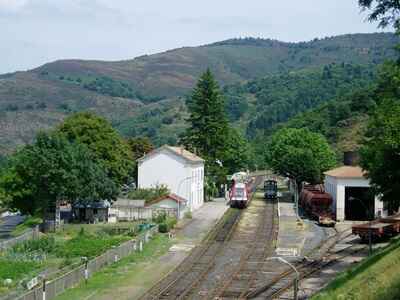 In Clermont-Ferrand (altitude 358 m), the station is located below the city, but the journey through the plain of Limagne allows one to quickly get acquainted with the promontory dominated by the spires of the cathedral and then with the rounded summit of Puy-de-Dôme. At Martres de Heyre, the line joins the Allier River. The river is followed, sometimes on one bank, sometimes on the other up to the outskirts of Arvant. Shortly before the temporary abandonment of the river, the line serves the coal basin of Brassac. The PLM network operated a factory on this site for producing agglomerates obtained from small coal, tars, and pitch, delivered in the form of small cylinders; these agglomerates replaced the briquettes, often marked "Aniche," used by other networks.
In Clermont-Ferrand (altitude 358 m), the station is located below the city, but the journey through the plain of Limagne allows one to quickly get acquainted with the promontory dominated by the spires of the cathedral and then with the rounded summit of Puy-de-Dôme. At Martres de Heyre, the line joins the Allier River. The river is followed, sometimes on one bank, sometimes on the other up to the outskirts of Arvant. Shortly before the temporary abandonment of the river, the line serves the coal basin of Brassac. The PLM network operated a factory on this site for producing agglomerates obtained from small coal, tars, and pitch, delivered in the form of small cylinders; these agglomerates replaced the briquettes, often marked "Aniche," used by other networks.
Through the valley of a tributary of the Allier, the route moves towards Arvant where the line divides from Neussargues - Le Lioran - Aurillac - Capdenac studied by Grand Central. Near La Roche Fougère, a platform stands out on the west side; this is for a connection with the line from Brioude to Saint-Flour, which constituted one of the elements of the shortest taxation distance for wines from the Midi to Paris. The platform is still waiting for its track, and that of the main line that connected to the Cévennes route at Beaumont - Lauriat has long been removed.
 Here we are in Brioude, which hosts the railway film festival every year. The line gives a nod to the Allier to cross it at the viaduct of La Bageasse, then, at Feugières le Pin, connects with one of its tributaries, whose course it follows all the way to the summit line. There is the junction station of Saint-Georges d'Aurac, the junction point with the line from Puy-en-Velay in Haute-Loire and Saint-Etienne in Loire.
Here we are in Brioude, which hosts the railway film festival every year. The line gives a nod to the Allier to cross it at the viaduct of La Bageasse, then, at Feugières le Pin, connects with one of its tributaries, whose course it follows all the way to the summit line. There is the junction station of Saint-Georges d'Aurac, the junction point with the line from Puy-en-Velay in Haute-Loire and Saint-Etienne in Loire.
From Clermont-Ferrand, the inclines have not exceeded 10 mm/m. A slope of 12 mm/m now allows us to find the Allier, crossed at the Costet viaduct (216 m) and which the line does not leave until La Bastide Puylaurent in Lozère. We serve Langeac (altitude 504 m), once a logistics center for trains on the Puy-en-Velay line. After Chanteuges, the interesting journey begins. The Allier valley narrows more and more to become a gorge. From supporting walls to tunnels, from tunnels to viaducts over the Allier or its tributaries, the line first reaches Langogne (altitude 911 m) where another line branches off, unfortunately closed, coming from Puy-en-Velay. On this route, the line crosses 8 major viaducts (including that of Chapeauroux) and 49 tunnels!
Moreover, from Prades Saint Julien to Langogne, no road runs through the gorges, and only the rail, with a maximum gradient of 15 mm/m, allows one to discover the wild beauty of the high valley with its steep walls and catch a glimpse of a few heavily ruined castles along the way.
From Langogne to La Bastide Puylaurent (altitude 1,023 m - junction for Mende and Marvejols), the passage becomes less severe, and the R.N. 106 shares the valley with the railway and the river via Luc. At La Bastide Puylaurent, snow is more famous for the snow removal tasks it imposes than for the joys of skiing. We let the Allier join its source, and now it's the descent from the Cévennes, passing through Prévenchères. And what a descent: a gradient of 25 mm/m down to Villefort (altitude 605 m), 10 mm/m down to Concoules-Ponteils (583 m), which serves two very remote villages, and again 25 mm/m down to Chamborigaud (329 m). A slight ascent and a long tunnel followed by a maximum slope of 22 mm/m allow us to reach the Gardon valley at Sainte Cécile d'Andorge (former junction to the narrow-gauge track to Florac).
 The southern and Mediterranean slope of the line differs significantly from the northern part. Here, there are no gorges; following winding, torrential rivers with a very irregular flow would prove impractical. Only the Chassezac is an exception, and even then for a short stretch. Thus, the line attacks the mountain from the side, traverses chestnut groves, weaves through every fissure, and often presents itself perpendicularly to the rivers. As a result, from La Bastide Puylaurent to Sainte Cécile d'Andorge, the traveler passes through 42 tunnels and crosses majestic viaducts: Chassezac near Prévenchères, Altier at Villefort, Malautiére near Concoules, Luech at Chamborigaud. The Albespeyre tunnel (1504 m), with a gradient of 25 mm/m between the stations of Prévenchères and Villefort, required the continuous operation of a ventilation plant.
The southern and Mediterranean slope of the line differs significantly from the northern part. Here, there are no gorges; following winding, torrential rivers with a very irregular flow would prove impractical. Only the Chassezac is an exception, and even then for a short stretch. Thus, the line attacks the mountain from the side, traverses chestnut groves, weaves through every fissure, and often presents itself perpendicularly to the rivers. As a result, from La Bastide Puylaurent to Sainte Cécile d'Andorge, the traveler passes through 42 tunnels and crosses majestic viaducts: Chassezac near Prévenchères, Altier at Villefort, Malautiére near Concoules, Luech at Chamborigaud. The Albespeyre tunnel (1504 m), with a gradient of 25 mm/m between the stations of Prévenchères and Villefort, required the continuous operation of a ventilation plant.
This brief description does not exclude, of course, a tribute to the builders who only had the technical means of the Second Empire style.
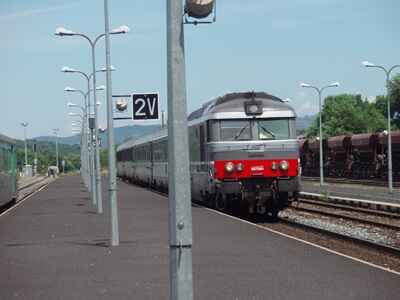 Here we are in the Gardon valley, quite enclosed, dotted with a few tunnels, and in the heart of the coal basin whose center is at Alès (altitude 135 m). The Alès star service, the transport for the mines, and the regional industries, notably chemical and metallurgical, have given great importance to the station. However, the exhaustion of the coal basin has led to the contraction of the facilities.
Here we are in the Gardon valley, quite enclosed, dotted with a few tunnels, and in the heart of the coal basin whose center is at Alès (altitude 135 m). The Alès star service, the transport for the mines, and the regional industries, notably chemical and metallurgical, have given great importance to the station. However, the exhaustion of the coal basin has led to the contraction of the facilities.
We leave the Gardon valley at Nozières Brignon. The line crosses a few viaducts and rises slightly to traverse the hills that dominate Nîmes, which, on their southern face, form the very arid Nîmes garrigue. A slope of 12 mm/m leads from Mas de Ponge (altitude 147 m) to the Courbessac installations, from where the train pushes forward to gain Nîmes passengers.
This situation has its origins in historical causes. The line from Alès to Beaucaire served Nîmes at the height of the current freight station and depot, and during the merger of the Mediterranean lines, a new station was built on a viaduct between the lines from Beaucaire and Montpellier. Certainly, it would have been possible to bypass Nîmes to the west, but at the cost of expensive works... The status quo was preferred.
So do not hesitate anymore. Treat yourself, with a tourist map in hand, to a journey on the Cévennes line. You won't regret it, especially if you enhance the trip with a stay in a village bordering the line. You will find the joy of calm life in the fresh air, and you will surely discover the little corner that will allow you to take stunning railway photographs.
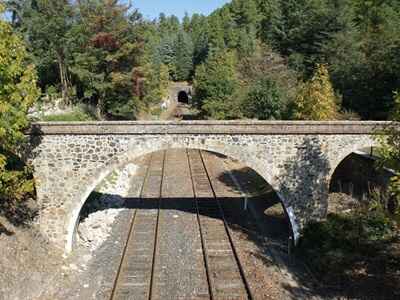 From Auvergne to Languedoc with the train "Le Cévenol"
From Auvergne to Languedoc with the train "Le Cévenol"
Improved over the years, the Cévenol, now a lively train, connects the shores of the Mediterranean to Paris, following a route that defies nature, especially in the gorges of the Allier.
The train bears the name of the wild mountains it traverses, southern foothills of the Massif Central, and contributes to the public's understanding of the Cévennes from perspectives unknown to automobile enthusiasts.
The extreme south of the Cévennes conceals significant coal deposits that provide excellent quality coal. However, the exploitation of these deposits presents serious difficulties. The coal seams are most often located on the mountain slopes of deep and enclosed valleys. In addition to the inconveniences resulting from the relief, there is a lack of flat locations to establish the necessary ground facilities: sorting, washing, storage, etc. Production is affected by this situation, and sales only modestly recoup the investments and efforts made by financiers and operators. Moreover, the extracted tonnage is difficult to sell: at the beginning of the 19th century, the road network of the mountainous Cévennes regions was sparse; traversed by carts, which collectively represented a significant tonnage, its maintenance left much to be desired.
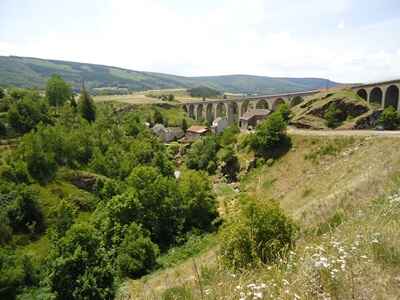 Natural phenomena: drought, heavy rains, floods, landslides add to the difficulty. Finally, the road transport of coal, which requires a lot of carts, horses, and men, burdens the price of fuel with prohibitive transport costs that prevent competition with foreign coals that arrive by sea at the coastal ports.
Natural phenomena: drought, heavy rains, floods, landslides add to the difficulty. Finally, the road transport of coal, which requires a lot of carts, horses, and men, burdens the price of fuel with prohibitive transport costs that prevent competition with foreign coals that arrive by sea at the coastal ports.
Operators cannot, of course, modify the natural framework of the deposits. At most, they can make costly modifications. But they learn that further north, in Forez, other operators, placed in similar natural conditions, have resorted to an English invention, the railway, to move production to the shores of navigable rivers.
The managers of the La Grand'Combe Mines (Messrs. Talabot, Veaute, Abric, and Mourier) follow the example of their predecessors and seek the concession of a line from Alès to Beaucaire via Nîmes, connecting their deposits with the Rhône and navigation canals. The State imposes a tender, preceded by an inquiry, based on transport rates. The submission by Messrs. Talabot and partners (0.17 F per ton-km uphill, 0.10 F per ton-km for coal, and 0.15 F for other goods downhill) is accepted, and a law of June 29, 1833 grants them the perpetual concession of the line initially planned only for freight traffic. An ordinance of October 19, 1835 approves the route.
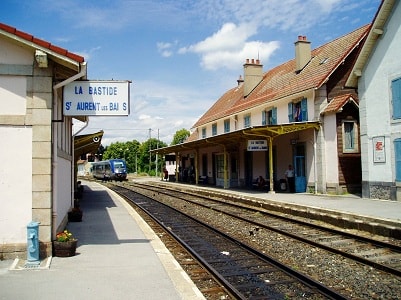 While the railway thus granted improved access to the coal basin, it did not irrigate it. A second concession, now limited to 99 years, concerns a line from Alès to La Grand'Combe, opened for passenger service (0.12 F/km) and freight (0.17 F/t.km uphill and 0.15 F downhill). The ordinance of May 12, 1836 thus places the railway within immediate reach of the wells. In 1839, there were 6 in the mountain of La Grand'Combe, 5 in that of Abylon, at Trescol, at La Levade, at Champclauson, and at Saint-Jean de Valériscle.
While the railway thus granted improved access to the coal basin, it did not irrigate it. A second concession, now limited to 99 years, concerns a line from Alès to La Grand'Combe, opened for passenger service (0.12 F/km) and freight (0.17 F/t.km uphill and 0.15 F downhill). The ordinance of May 12, 1836 thus places the railway within immediate reach of the wells. In 1839, there were 6 in the mountain of La Grand'Combe, 5 in that of Abylon, at Trescol, at La Levade, at Champclauson, and at Saint-Jean de Valériscle.
For the execution of railway works, there are numerous difficulties; only the section from Nîmes to Beaucaire, built in the plain, is opened to traffic on July 16, 1839. Initially, it only serves passenger traffic (average 500 per day), with freight traffic gradually organizing by the end of the year. It is probable that the company, from the end of 1839, conducts coal transport for its own account between La Grand'Combe and Alès. Passenger transport is organized by the end of February 1840. The inauguration of the section from Alès to Nîmes takes place on August 19, 1840. From then on, coal can reach the Rhône, but on November 3, 1840, a rupture of the river's dikes floods the entire delta, rendering Beaucaire's outlets impassable. North of Alès, public traffic is definitively organized, according to statistics from the Ministry of Public Works in January 1841, according to PLM documents on October 25, 1841, up to La Verrerie (La Grand'Combe) and La Levade (Trescol).
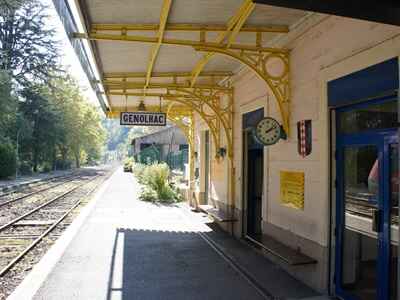 In summer 1847, there are 4 trains between Nîmes and Beaucaire (1st, 2nd, and 3rd classes) but only 2 with 4 classes and 2 hours of travel from Alès to Nîmes. Between La Levade and Alès, there are no published schedules, and it can be assumed that the transport of miner workers and local users was done by freight trains. Until 1849, passenger service is conducted at Alès in two separate stations for Nîmes and La Levade. As this operation between La Levade and Beaucaire remains quite unknown, we believe it is interesting to provide some indications on the material.
In summer 1847, there are 4 trains between Nîmes and Beaucaire (1st, 2nd, and 3rd classes) but only 2 with 4 classes and 2 hours of travel from Alès to Nîmes. Between La Levade and Alès, there are no published schedules, and it can be assumed that the transport of miner workers and local users was done by freight trains. Until 1849, passenger service is conducted at Alès in two separate stations for Nîmes and La Levade. As this operation between La Levade and Beaucaire remains quite unknown, we believe it is interesting to provide some indications on the material.
These figures, with their variations, testify to an operation that is searching for itself. To normalize it, it is necessary to involve experts in railway matters. This is one of the objectives of a first merger: by agreement of June 19, 1852, the Lyon to Avignon Company buys the Gard Railways for 30,000 4% bonds of 1000 F issued by the Lyon Mediterranean Company, redeemable in 99 years and supplemented by additional titles based on the net product of the different lines acquired. A second agreement, made the same day between the Minister of Public Works and the Lyon Mediterranean Company, and approved by the law of July 8, 1852, authorizes the transfer with unification of concessions.
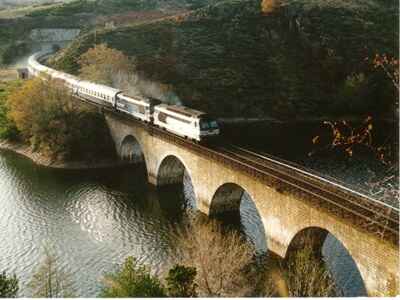 In the North, the domain of Grand Central
In the North, the domain of Grand Central
The concessions granted by the State to the Centre Company, merged with the P.O in 1852, stop at Clermont-Ferrand. The Grand Central Company, chaired by the Duke of Morny, wishes to connect to these concessions east-west lines, from Bordeaux to Lyon, and north-south, notably between Clermont-Ferrand and Montauban.
The government reserves these overly ambitious projects for the future and, by agreement of March 30, 1853, approved by decree on April 21, 1853, limits the concessions, in the area that concerns us, to:
- Clermont-Ferrand to Lempdes, granted definitively
- Saint-Etienne to the line from Montauban to the Lot, granted provisionally.
The first line mentioned, for which studies were undertaken previously, is immediately tackled by contract, at a rate of 136,400 F per kilometer, by Mr. Julien Lacroix.
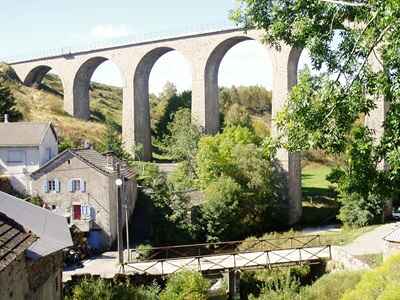 While the work is underway, a convention of February 2 and April 2/6, 1855, approved by decree on April 7, 1855, and sanctioned by a law of May 2, 1855, makes definitive the provisional concession of 1853.
While the work is underway, a convention of February 2 and April 2/6, 1855, approved by decree on April 7, 1855, and sanctioned by a law of May 2, 1855, makes definitive the provisional concession of 1853.
On July 2, 1855, Grand Central trains run between Clermont-Ferrand and Issoire, with service via a 4 km branch to the sugar factory of Bourdon administered by Morny.
On September 3, 1855, they reach Brassac and its mines, served by a one-kilometer branch. On May 3, 1856, they arrive at Arvant.
Grand Central also continues the work towards Brioude as part of the Bordeaux-Lyon link. The company chaired by Morny has spread its efforts too thin over a network that is too extensive and difficult to execute. Victim of the financial crisis, Grand Central must cede its concessions partly to the newly formed PLM, partly to the P.O. The agreement of April 11, 1857 regulates the division. The PLM inherits, in particular, the line from Clermont Ferrand to Brioude, opened on May 1, 1857, and access to Saint-Etienne. Beyond that, towards Saint-Georges d'Aurac, no work has yet been undertaken.
On the same day, the Ministry signs an agreement with representatives of the PLM approving the sharing treaties. As such an agreement always implies the acceptance of new concessions, the PLM receives, among others, the eventual concession of a line from Brioude to Alès, whose route must be coordinated with the line from Brioude to Puy-en-Velay (Saint-Etienne). The decree of June 19, 1857, ratifies the agreement, and the PLM takes possession of its share of Grand Central on July 1, 1857. The PLM-P.O border is, after many twists and turns, definitively established.
SNCF Schedules: SBB Schedule, SNCF-Occitanie ![]()
Former holiday hotel with a garden along the Allier, L'Etoile Guest House is located in La Bastide-Puylaurent between Lozere, Ardeche, and the Cevennes in the mountains of Southern France. At the crossroads of GR®7, GR®70 Stevenson Path, GR®72, GR®700 Regordane Way, GR®470 Allier River springs and gorges, GRP® Cevenol, Ardechoise Mountains, Margeride. Numerous loop trails for hiking and one-day biking excursions. Ideal for a relaxing and hiking getaway.
Copyright©etoile.fr